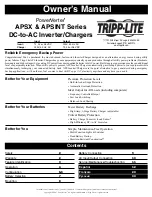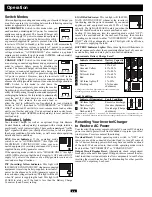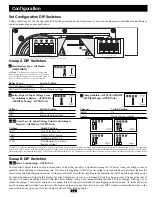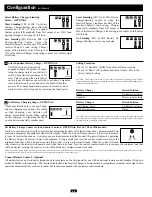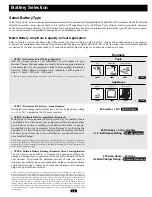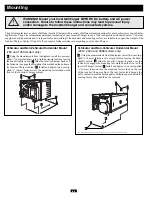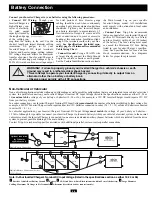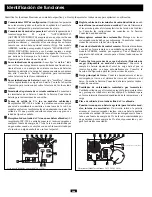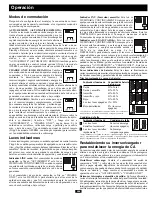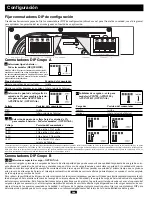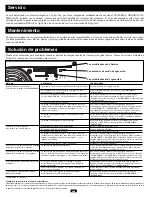
7A
Battery Selection
540 watts ÷ 12V =
45 DC Amps
45 DC Amps × 5 Hrs. Runtime
× 1.2 Inefficiency Rating =
270 Amp-Hours
270 Amp-Hours ÷ 30 Amps
Inverter/Charger Rating =
9 Hours Recharge
Select Battery Type
Select “Deep Cycle” batteries to enjoy optimum performance from your Inverter/Charger. Batteries of either Wet-Cell (vented) or Gel-Cell /Absorbed
Glass Mat (sealed) construction are ideal. 6-volt “golf cart,” Marine Deep-Cycle or 8D Deep-Cycle batteries are also acceptable. You must
set the Inverter/Charger’s Battery Type DIP Switch (see Configuration section for more information) to match the type of batteries you connect
or your batteries may be degraded or damaged over an extended period of time.
Match Battery Amp-Hour Capacity to Your Application
Select a battery or system of batteries that will provide your Inverter/Charger with proper DC voltage and an adequate amp-hour capacity
to power your application. Even though Tripp Lite Inverter/Chargers are highly-efficient at DC-to-AC inversion, their rated output capacities
are limited by the total amp-hour capacity of connected batteries plus the output of an alternator when one is used.
• STEP 1) Determine Total Wattage Required
Add the wattage ratings of all equipment you will connect to your
Inverter/Charger. Wattage ratings are usually listed in equipment manuals
or on nameplates. If your equipment is rated in amps, multiply that number
times AC utility voltage to estimate watts. (Example: a drill requires 1.3
amps. 1.3 amps × 230 volts = 300 watts.)
NOTE: Your Inverter/Charger will operate at higher efficiencies at about 75% - 80% of nameplate rating.
• STEP 2) Determine DC Battery Amps Required
Divide the total wattage required (from step 1, above) by the battery voltage
(i.e. 12 or 24) to determine the DC amps required.
• STEP 3) Estimate Battery Amp-Hours Required
Multiply the DC amps required (from step 2, above) by the number of hours
you estimate you will operate your equipment exclusively from battery
power before you have to recharge your batteries with utility- or genera-
tor-supplied AC power. Compensate for inefficiency by multiplying this
number by 1.2. This will give you a rough estimate of how many amp-hours
of battery power (from one or several batteries) you should connect to
your Inverter/Charger.
NOTE: Battery amp-hour ratings are usually given for a 20-hour discharge rate. Actual amp-hour capacities
are less when batteries are discharged at faster rates. For example, batteries discharged in 55 minutes
provide only 50% of their listed amp-hour ratings, while batteries discharged in 9 minutes provide as little
as 30% of their amp-hour ratings.
• STEP 4) Estimate Battery Recharge Required, Given Your Application
You must allow your batteries to recharge long enough to replace the
charge lost during inverter operation or else you will eventually run down
your batteries. To estimate the minimum amount of time you need to
recharge your batteries given your application, divide your required battery
amp-hours (from step 3, above) by your Inverter/Charger’s rated charging
amps (see Specifications section).
NOTE: For Tripp Lite Inverter/Chargers providing 1000 watts or less of continuous AC power, a full-size
battery will normally allow sufficient power for many applications before recharging is necessary. For
mobile applications, if a single battery is continuously fed by an alternator at high idle or faster, then recharging
from utility or generator power may not be necessary. For Tripp Lite Inverter/Chargers over 1000 watts used
in mobile applications, Tripp Lite recommends you use at least two batteries, if possible fed by a heavy-duty
alternator anytime the vehicle is running. Tripp Lite Inverter/Chargers will provide adequate power for
ordinary usage within limited times without the assistance of utility or generator power. However, when
operating extremely heavy electrical loads at their peak in the absence of utility power, you may wish to
“assist your batteries” by running an auxiliary generator or vehicle engine, and doing so at faster than
normal idling.
Example
Tools
300W + 220W + 20W
=
540W
Drill
Orbital Sander
Cordless Tool Charger
Appliances
300W + 140W + 100W
=
540W
Blender
Color TV
Laptop Computer
200711152 93-2752 230V APS OM.qxd 11/29/2007 2:15 PM Page 7

